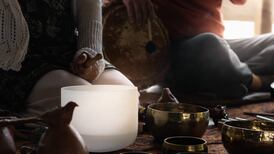Getting back to Trumpeter Landfried (An Irishman's Diary, October 27th), a survivor of the charge of the Light Brigade whose voice is preserved on record, complete with Irish accent, I am indebted to reader Philip Boys for filling some gaps in the story.
Among other things, I now know that Landfried's mother was a Long from Limerick. But the tale begins with his presumed father, Leonard Landfried, a globe-trotting Canadian who was himself a military musician.
Landfried snr’s enthusiasm for music landed him in trouble at least once. In May 1826, he was court martialled for “cutting out several sheets from the band music book and appropriating the same for his own use”. The result was demotion, from corporal to private, which was soon reversed and then reinstated for unspecified reasons.
He recovered from his privatisations, however, to marry Margaret Long in 1830. And after postings in various parts of Europe, he quit the army in 1840, aged 39, with an almost-glowing reference: "Has been good latterly."
Light Entertainment - An Irish voice from the Charge of the Light Brigade
Jail Journeyman – On Behan’s lighthouse, the glory of French supermarkets, and confidence-building Christian names
Ring Cycle – Frank McNally on Brendan Behan and the Fáinne wearers
Theatrical night out – with the Treaty debates providing the drama
He was then living in Plymouth but when he died six years later, it was in “the Dublin pension district”.
His trumpeter son Martin, born in Gibraltar, had by then recently enlisted in Dublin, aged 14, "by special authority and to go to the band". The youngster may have been one of the Longs of Limerick by maternal heritage, but he was not long himself. Service records state that he was only 147cm (4ft 10in).
Diminutive size may have been an advantage 10 years later during the infamous charge at Balaclava, when he was shot only in the arm (the bullet then ricocheted and killed his horse). Unlike so many of his comrades, he lived, and as mentioned here earlier in the week went on to become one of the celebrity survivors, the only one whose voice we can still hear.
In The Irish Times archive’s sole mention of him, by the way, he is described as being one of the main attractions at the 1890 Lord Mayor’s show in London, when the band serenaded him with The Boys of the Old Brigade (not the Irish rebel version, obviously).
My correspondent Philip Boys's fascinating website, Chargeofthelightbrigade. com, based on the EJ Boys Archive is a treasure trove of information.
Still with music and (indirectly) militaria, another reader has sought help in establishing for once and all the true authorship of the great Irish prison ballad, The Ould Triangle.
It is often credited to Brendan Behan because it was first performed in his play, The Quare Fella. Others attributed it to his brother Dominic, because he wrote many songs and may once have claimed the credit for this one too. But Deasún Ó Seanáin is certain that his uncle, Richard "Dicky" Shannon, wrote the ballad. And I believe he may be right.
The nearest Brendan Behan ever got to setting the record straight was in conversation with Micheál Ó hAodha, a radio producer whose programme featured the song. Writing in this newspaper in 1974, Ó hAodha recalled: "Behan, to my knowledge, never claimed authorship of The Old Triangle. In fact, he asked me to send a small copyright fee to Dick Shannon of Inchicore, which I did. Whether he wanted to do a pal in need a good turn or that Shannon was [sole composer] of The Old Triangle, I am still not certain."
On the programme, Behan introduced it cryptically: “This song was written by a person who will never hear it recorded, because he’s not in possession of a gramophone. He’s...he’s..pretty much a tramp.”
The Shannon family dispute this description. They say Dicky was a witty, highly articulate man. But he certainly grew up poor and tough, the son of a first World War soldier and later a resident of what became one of Dublin's most infamously impoverished addresses: Keogh Square.
When the British army withdrew from Ireland in the 1920s, Richmond Barracks was converted to civilian accommodation for 248 families – the "barrackers" – and renamed Keogh Square. It was at first a good place to live. By the 1950s, conditions had worsened considerably which might explain why Shannon resorted to petty crime, landing himself in Mountjoy while Behan was there.
Were his authorship of the famous ballad to be proven, Ó Seanáin thinks it would merit a plaque, at least, where Keogh Square used to stand. If it was indeed the Square that spawned the Triangle, the Shannons hope, there may still be somebody out there who can close the circle.















